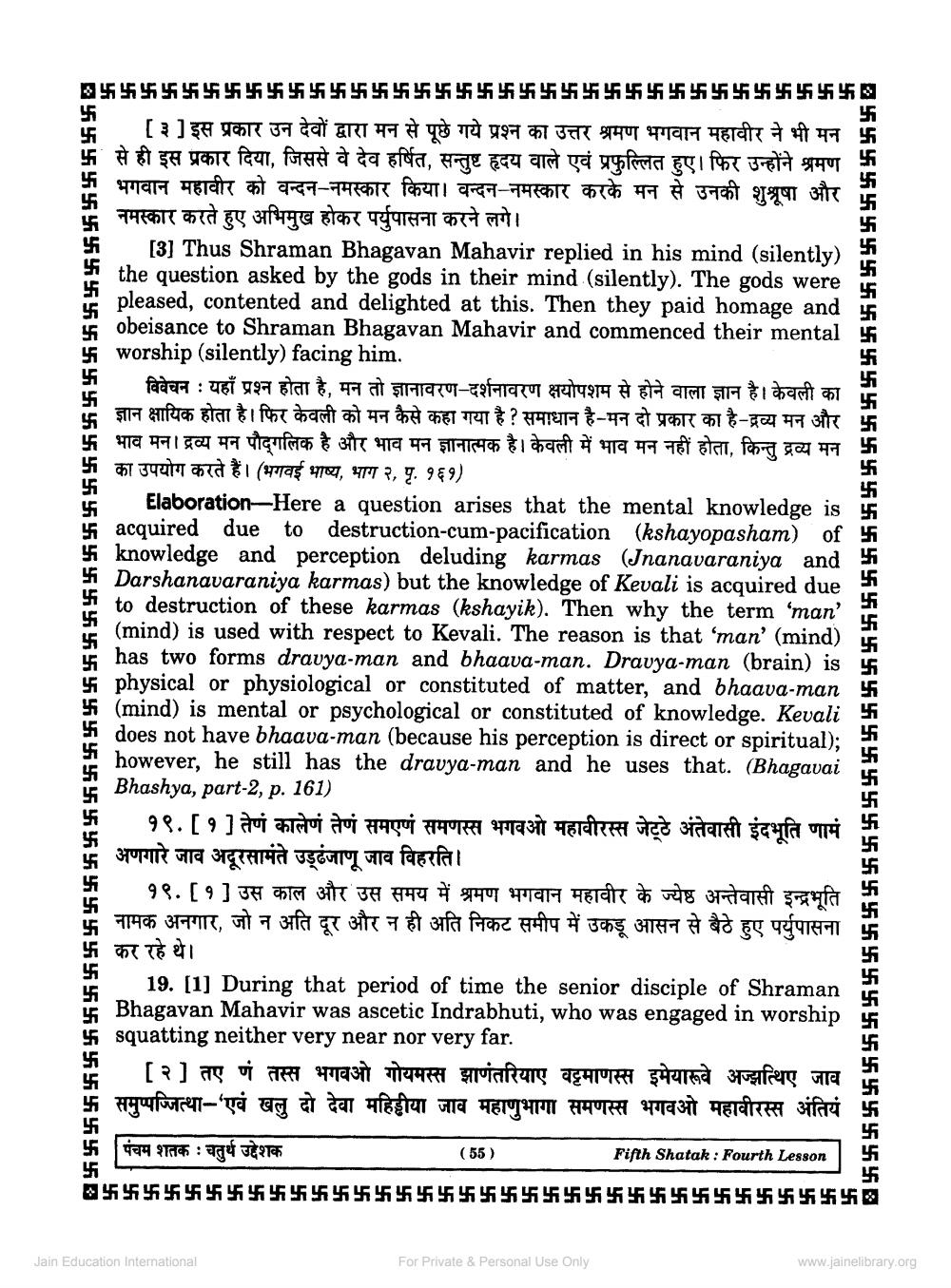________________
白听听听听听听听听听听
35555555555555555555555555555555555555555555
+ [३] इस प्रकार उन देवों द्वारा मन से पूछे गये प्रश्न का उत्तर श्रमण भगवान महावीर ने भी मन के
से ही इस प्रकार दिया, जिससे वे देव हर्षित, सन्तुष्ट हृदय वाले एवं प्रफुल्लित हए। फिर उन्होंने श्रमण ॥ भगवान महावीर को वन्दन-नमस्कार किया। वन्दन-नमस्कार करके मन से उनकी शुश्रूषा और 4 नमस्कार करते हुए अभिमुख होकर पर्युपासना करने लगे। 31 Thus Shraman Bhagavan Mahavir replied in his mind (silent)
in his mind (silently) the question asked by the gods in their mind (silently). The gods were pleased, contented and delighted at this. Then they paid homage and obeisance to Shraman Bhagavan Mahavir and commenced their mental worship (silently) facing him.
विवेचन : यहाँ प्रश्न होता है, मन तो ज्ञानावरण-दर्शनावरण क्षयोपशम से होने वाला ज्ञान है। केवली का ज्ञान क्षायिक होता है। फिर केवली को मन कैसे कहा गया है ? समाधान है-मन दो प्रकार का है-द्रव्य मन और भाव मन। द्रव्य मन पौद्गलिक है और भाव मन ज्ञानात्मक है। केवली में भाव मन नहीं होता, किन्तु द्रव्य मन का उपयोग करते हैं। (भगवई भाष्य, भाग २, पृ. १६१)
Elaboration-Here a question arises that the mental knowledge is ॐ acquired due to destruction-cum-pacification (kshayopasham) of 45 knowledge and perception deluding karmas (Jnanavaraniya and
Darshanavaraniya karmas) but the knowledge of Kevali is acquired due to destruction of these karmas (kshayik). Then why the term 'man' (mind) is used with respect to Kevali. The reason is that 'man' (mind)
has two forms dravya-man and bhaava-man. Dravya-man (brain) is 4 physical or physiological or constituted of matter, and bhaava-man
(mind) is mental or psychological or constituted of knowledge. Kevali
does not have bhaava-man (because his perception is direct or spiritual); Phowever, he still has the dravya-man and he uses that. (Bhagavai Bhashya, part-2, p. 161)
१९. [१] तेणं कालेणं तेणं समएणं समणस्स भगवओ महावीरस्स जेठे अंतेवासी इंदभूति णामं अणगारे जाव अदूरसामंते उड्ढंजाणू जाव विहरति।
१९. [१] उस काल और उस समय में श्रमण भगवान महावीर के ज्येष्ठ अन्तेवासी इन्द्रभूति E नामक अनगार, जो न अति दूर और न ही अति निकट समीप में उकडू आसन से बैठे हुए पर्युपासना ॐ कर रहे थे। ___19. [1] During that period of time the senior disciple of Shraman
Bhagavan Mahavir was ascetic Indrabhuti, who was engaged in worship 4 squatting neither very near nor very far.
[२] तए णं तस्स भगवओ गोयमस्स झाणंतरियाए वट्टमाणस्स इमेयारूवे अज्झथिए जाव ॐ समुप्पज्जित्था-'एवं खलु दो देवा महिड्डीया जाव महाणुभागा समणस्स भगवओ महावीरस्स अंतियं
855555555555555555555555555554155555)))
|पंचम शतक : चतुर्थ उद्देशक
(55)
Fifth Shatak : Fourth Lesson
Jain Education International
For Private & Personal Use Only
www.jainelibrary.org




